Connectors and cable assemblies are now capable of withstanding the most demanding environments, thanks to advancements in technology and the development of materials for mold compounds. As a result of these new developments, cable assembly overmolds are used in almost every industry and application. Cable assembly overmolds allow for a soft tactile feel, provide surfaces that can be held onto while using gloves, bond to the backshell and cable to provide ingress protection from water and dust (IP67 & IP68 sealing), provide strain or bend relief to protect the termination points and contacts, provide shock and vibration protection to eliminate fatigue and other damage, and provide resistance to physical abuse and abrasion from rugged environments.
Omnetics offers experience in the design and manufacturing of high quality overmolded cables for a variety of medical, military, and industrial applications that may require prototypes, quick turn, or low or high volume production. Our focus is on engineering overmolded cables using our in-house Milacron vertical injection molding machines that are built to meet or exceed your exact specifications. A wide range of physical and material properties are available:

The material selection process is critical to meeting the demands of the engineer’s application, so Omnetics can work directly with design engineers to help choose the best material for his or her needs. Electrical properties are also critical; Polyurethane is one of the best materials for control of items such as high dielectric strength and resistivity while retaining resistance to wear, exposure to chemicals, and retaining flexibility. The dielectric constant, a measure of an insulator’s ability to store electrical energy, is the ratio of the electrical capacity of an elastomer to store electrical energy to the capacity of a similar material made mostly of air. One factor that influences the dielectric constant is frequency of the signals, and tests may be run from as low as 25 cycles per second up to many megacycles per second.
The power factor of an electrical insulation material indicates its tendency to generate heat in service. If a capacitor using an elastomer as the dielectric is charged by a direct current and then immediately discharged, there is an energy loss in the form of heat. The ratio of this loss to the energy required to charge the capacitor is known as power factor. It’s expressed as a decimal fraction or a percent of the charging energy, which ensures compatibility and that it is suitable for military and rugged applications cooling systems; per the ASNI/VITA specifications.
One example of Omnetics selecting an over molding material for a specific application is in the use of Polyurethane Estane for portable military electronics. This material is a halogenated flame retardant compound with good low temperature properties and strong cut resistance. It is injection overmolded onto cables and connectors that will experience high use, provide IP68 sealing, and be exposed to a wide range of rugged environments. Another advantage of this material is that it does not require massive thickness to function and protect the electronics.
Omnetics is also very experienced in the use of thermoplastic elastomers (TPE) compounds. Omnetics regularly uses Evoprene for cable and connector products being utilized on medical devices worn by humans. The Evoprene being overmolded is based on the widely specified SEBS (Styrene – Ethylene Butylene – Styrene). These polymers are fully saturated, so there are no double bonds. Evoprene also offers high resistance to oxidation, making it an excellent material for outdoor wear. This material lends itself to superior mold quality and finished surfaces, even when mold material is held to very thin coating. Flexibility and ruggedness of these ultra-thin connector assemblies cannot be surpassed with other materials.
Contact Vermont Rep today to learn more about the overmolding processes.


